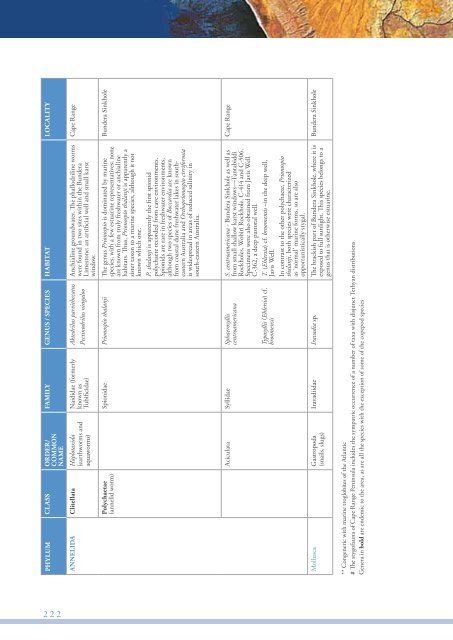Acknowledgements and Appendices - Department of the ...
Acknowledgements and Appendices - Department of the ...
Acknowledgements and Appendices - Department of the ...
You also want an ePaper? Increase the reach of your titles
YUMPU automatically turns print PDFs into web optimized ePapers that Google loves.
FAMILY GENUS / SPECIES HABITAT LOCALITY<br />
PHYLUM CLASS ORDER/<br />
COMMON<br />
NAME<br />
2 2 2<br />
Cape Range<br />
Anchialine groundwater. The phallodriline worms<br />
were found in two sites within <strong>the</strong> Bundera<br />
Limestone: an artificial well <strong>and</strong> small karst<br />
window.<br />
Aktedrilus parvi<strong>the</strong>catus<br />
Pectinodrilus ningaloo<br />
Naididae (formerly<br />
known as<br />
Tubificidae)<br />
ANNELIDA Clitellata Haplotaxida<br />
(earthworms <strong>and</strong><br />
aquaworms)<br />
Bundera Sinkhole<br />
Spionidae Prionospio thalanji The genus Prionospio is dominated by marine<br />
species, with a few estuarine representatives; none<br />
are known from truly freshwater or anchialine<br />
habitats. Thus, Prionospio thalanji is apparently a<br />
sister taxon to a marine species, although it not<br />
known which one.<br />
P. thalanji is apparently <strong>the</strong> first spionid<br />
polychaete recorded from cave environments.<br />
Spionids are rare in freshwater environments,<br />
although two species <strong>of</strong> Boccardia are known<br />
from coastal dune freshwater lakes in sou<strong>the</strong>astern<br />
Australia <strong>and</strong> Orthoprionospio cirriformia<br />
is widespread in areas <strong>of</strong> reduced salinity in<br />
south-eastern Australia.<br />
Polychaetae<br />
(annelid worm)<br />
Cape Range<br />
S. centroamericana ‑ Bundera Sinkhole as well as<br />
from small shallow karst windows—Tantabiddi<br />
Rockholes, Wobiri Rockhole, C-414 <strong>and</strong> C-506.<br />
Specimens were also obtained from Javis Well<br />
C-362, a deep pastoral well.<br />
T. (Ehlersia) cf. broomensis –in <strong>the</strong> deep well,<br />
Javis Well.<br />
In contrast to <strong>the</strong> o<strong>the</strong>r polychaete, Prionospio<br />
thalanji, both species were characterized<br />
as ‘normal’ marine forms, so are also<br />
Aciculata Syllidae Sphaerosyllis<br />
centroamericana<br />
Typosyllis (Ehlersia) cf.<br />
broomensis<br />
opportunistically stygal.<br />
Bundera Sinkhole<br />
Iravadiidae Iravadia sp. The brackish part <strong>of</strong> Bundera Sinkhole, where it is<br />
exposed to full sunlight. This species belongs to a<br />
genus that is o<strong>the</strong>rwise estuarine.<br />
Mollusca Gastropoda<br />
(snails, slugs)<br />
** Congeneric with marine troglobites <strong>of</strong> <strong>the</strong> Atlantic<br />
# The styg<strong>of</strong>auna <strong>of</strong> Cape Range Peninsula includes <strong>the</strong> sympatric occurrence <strong>of</strong> a number <strong>of</strong> taxa with disjunct Tethyan distributions<br />
Genera in bold are endemic to <strong>the</strong> area, as are all <strong>the</strong> species with <strong>the</strong> exception <strong>of</strong> some <strong>of</strong> <strong>the</strong> copepod species
















